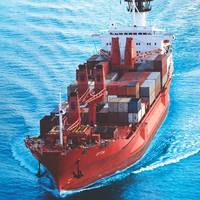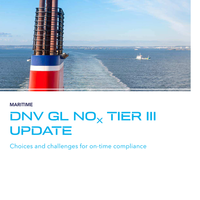Keeping a Tight Lid on Tier III & Sealing Solutions

With more than 90 percent of global trade carried by sea, shipping is a major battleground in the reduction of emissions. Tier III is the latest emission standard pertaining to NOx emissions from marine diesel engines. Tier IV is expected to come into effect for 2020 – with engine manufacturers already seeking sealing components to future-proof engines well into the next decade. Here we explore challenges faced by diesel engine operators in the face of Tier III, and how the correct selection of sealing materials could deliver better performing solutions.
DNV GL Updates NOx TIER III Compliance Guide

Classification society DNV GL has developed a new brochure to offer a set of best practices for the design of ships subject to NOx Tier III requirements. It also offers guidance on the considerations that should be taken into account at the newbuilding stage. To ensure the success of any newbuilding plan, shipowners should carefully consider the future operation of their vessels in the newbuilding planning stage, including the implications of the different technological solutions for reducing NOx emissions and how to fulfil the NOx Tier III requirements.
Air Emission Regulation Update

In March this year, The U.S. Environmental Protection Agency proposal to designate waters off the North American coasts as an Emission Control Area was adopted by IMO, the International Maritime Organization. The North American ECA is a key part of a comprehensive EPA program to address harmful emissions from large ships. Which are the time schedules of upcoming emission regulations? How are marine engine manufacturers preparing for the tighter air emission limits being adopted? Henrik Segercrantz explores.
CIMAC Circle at Marintec Shanghai
CIMAC, the International Council for Combustion Engines took advantage of this year’ s major trade show in the large engine sector to stage the latest in its CIMAC Circle series of forums for information exchange. Chaired by CIMAC board member Yasuhiro Itoh, Managing Director, Niigata Power Systems Co., Ltd., the Circle was entitled “Life-Cycle Costs - the Impact of Fuel and Emissions,” and with contributions from a full spectrum of stakeholders gave a timely and comprehensive snapshot of present and predicted costs of engine ownership in the light of tightening marine emissions legislation. Especially significant, the CIMAC Circle took place for the third time in China.
P&O Princess Cruises Picks EnviroEngines
Wärtsilä Corporation was tapped to supply 12 EnviroEngines for four cruise ships contracted by P&O Princess Cruises. Wärtsilä EnviroEngines employ electronically controlled common-rail fuel injection to provide optimum combustion over the entire load range, to give the particular benefit of no visible smoke at any load and when starting or during transient load changes. They also employ electronically controlled direct water injection to achieve the low NOx emission value of 6 g/kWh. These EnviroEngines for P&O Princess Cruises are the first to incorporate both technologies. As diesel engines, their high efficiency also means they have the lowest CO2 emissions of all prime movers.
Fortum Newbuildings Will Get Wärtsilä Engines
Wärtsilä Corporation has received a contract to supply the complete power systems for two 14,000 tdw product/chemical tankers under construction for the Finnish energy group Fortum. The two tankers have been contracted at the Portuguese shipbuilder Estaleiros Navais de Viana do Castelo, with delivery due in 2003. With a cargo capacity of 16,000 cu m, they are of 140 m length overall by 21.7 m breadth, and have a service speed of 16 knots. They are also being built to ice class 1A Super. Each Wärtsilä power system comprises a Wärtsilä 8L46 main engine, reduction gearbox with power take-off (PTO) drive, controllable-pitch propeller, and three generating sets, two driven by Wärtsilä 6L20 engines and one by a Wärtsilä 4L20 engine.
Fortum Get Wärtsilä Engines
Wärtsilä Corporation has received a contract to supply the complete power systems for two 14,000 tdw product/chemical tankers under construction for the Finnish energy group Fortum. The two tankers have been contracted at the Portuguese shipbuilder Estaleiros Navais de Viana do Castelo, with delivery due in 2003. With a cargo capacity of 16,000 cu m, they are of 140 m length overall by 21.7 m breadth, and have a service speed of 16 knots. They are also being built to ice class 1A Super. propeller, and three generating sets, two driven by Wärtsilä 6L20 engines and one by a Wärtsilä 4L20 engine. power of 8400 kW each, the 8L46 main engines will be equipped with Direct Water Injection (DWI) for reduced NOx emissions.
Tapping LNG on the fjords
In the first application of its type in marine propulsion, a Norwegian fjord ferry is to use LNG (liquefied natural gas)-fueled engines as the prime movers for a gas-electric powering and drive system. While primarily an environmental initiative, the use of the 'clean' energy source also holds out the prospect of reduced engineering maintenance outgoings over the long-term. Although Scandinavia remains in the vanguard of 'lean-burn' technology, the plant for the 312 ft. (95-m), double-ended RoRo passenger ferry for operation in the western county of More & Romsdal will be of Japanese origin. It is claimed that the Mitsubishi gas engines…
Marine Innovations
In extending its adherence to delivering cost-efficient and safety driven technologies, DNV has introduced a new means of quickly and accurately determining steel thickness can speed ship surveys. It is especially valuable in inspecting old and corroded steelwork. Present-day methods, based on ultrasonic thickness measurements, are said to have dubious reliability on heavily corroded plates, and for large vessels are also considered too slow. The basic technological challenge was to transmit 100 percent of the signal energy through corroded steel plates, and receive and interpret the reflected signal to give an accurate thickness measurement. The basic principles of the new measuring method (half-wave resonance) have been known for 40 years.
New Marine Technology: The Hallmark of SMM 2000
The SMM exhibition in Hamburg has once again proven that it is the cradle of marine technology and the grand-daddy of all marine exhibitions. On display in 12 separate halls were more than 1,300 exhibitors from more than 50 countries, launching new products and discussing business with an estimated 37,000 visitors. More telling that sheer numbers, in this case, is the feeling of the exhibition and the ubiquitous marine technology theme. The quality of attendee and exhibitor is always high, but this edition of the bi-annual exhibition seemed especially charged due to the many positives currently running throughout the full spectrum of the maritime market.
Q&A with Wärtsilä CTO Matti Kleimola
Prof. Matti Kleimola, Chief Technology Officer (CTO) for Wärtsilä Corporation, was recently elected as President of CIMAC. He is a member of Wärtsilä Board of Management, Technology and Environment, and Head of Corporate Technology, including R&D. MR took a few moments to discuss with him emerging trends in the marine propulsion market. Q What is your area of responsibility as the new president of CIMAC. A The aim of CIMAC is to promote exchange of technical and scientific knowledge, to improve understanding between manufacturers, users and suppliers, to promote the work and activities of national associations in the field of combustion engines technology (piston engines and gas turbines) in marine/ship propulsion, power generation, rail traction and industrial applications.
Wärtsilä: Smokeless by Common Rail
There are two main ingredients to common rail fuel injection, one being the freedom to choose injection pressure and timing totally independently of the engine load. The other is computerized control, which makes it possible to consider several engine parameters and optimize the injection and combustion in each load situation. The Wärtsilä Common Rail development was kicked off for both medium-speed engines and low-speed engines at a seminar in June 1997. This year both medium-speed engines and low-speed engines will enter commercial service. The Wärtsilä Common Rail concept for four-stroke engines comprises: Camshaft driven high-pressure pumps…
Recent Wärtsilä Four-Stroke Engine Developments
Wärtsilä has focused its technological developments in this realm on three main areas: Common-rail fuel injection for heavy-fuel engines; Humidification methods for reduction of NOx; and Dual-fuel engines with micro pilot. Long-term research on the concepts hot combustion for combined cycles and steam injected diesel is also going on. Three engine types, i.e. the Wärtsilä 46, Wärtsilä 38 and Wärtsilä 32 have - so far - been made available for the common-rail injection systems. The pilot engine, which sails onboard the Carnival Spirit, has to date gathered more than 3,500 hours of operational experience, and the Wärtsilä 46 test engine has more than 3,000 hours as well.
Coral Princess Employs Innovation in Propulsion
Coral Princess’ propulsion system is the first in the cruise industry to fully utilize a new development of the diesel engine known as an EnviroEngine, as well as the first in the Princess fleet to incorporate gas turbine power generation. This combination uses technology proven to be both highly efficient and environmentally sound, and, in a unique design development where the gas turbine is installed in the ship funnel, provides additional space for a wider range of public rooms and onboard facilities. Coral Princess is powered by one gas turbine that operates in conjunction with two diesel EnviroEngines. The turbine replaces at least two diesel engines and by using two separate power systems, this unique one-of-a-kind configuration creates a very reliable and safe energy source.
Carnival, Wärtsilä Clearing The Air
As the world's cruise lines grow exponentially larger and are increasingly falling under the gaze of environmental and regulatory bodies, the push to ensure that ships are run safely, efficiently and environmentally sound gains new importance each day. The world's largest cruise ship company - Carnival Corporation (CCL) - has hooked up with one of the premier builders of marine diesel engines - Wärtsilä NSD - to develop a smokeless diesel-electric propulsion system for cruise ships. Code-named "project enviroengine," prototypes of the new engine are expected to be available later this year for laboratory testing and are expected to be available commercially in 2001. Following successful completion of testing, Carnival plans to utilize those engines on its future newbuilds.
Carnival, Wärtsilä Clearing The Air
As the world’s cruise lines grow exponentially larger and are increasingly falling under the gaze of environmental and regulatory bodies, the push to ensure that ships are run safely, efficiently and environmentally sound gains new importance each day. The world’s largest cruise ship company -- Carnival Corporation (CCL) -- has hooked up with one of the premier builders of marine diesel engines -- Wärtsilä NSD -- to develop a smokeless diesel-electric propulsion system for cruise ships. Code-named "project enviroengine," prototypes of the new engine are expected to be available later this year for laboratory testing and are expected to be available commercially in 2001. Following successful completion of testing, Carnival plans to utilize those engines on its future newbuilds.
A broader-based payback from R&D
Consolidation in the diesel engine building sector is partly a reflection of the substantial capital expenditure required to maintain product development and technological advance in a business characterized by comparatively low unit margins. By spinning-off new technical solutions arising from the engine design program into upgrading and conversion packages for existing populations of machinery, the manufacturer and licensor can gain more from R&D endeavors. Complementing new engine sales, product releases aimed at plant already in operation represents another stream of payback on heavy investment in technology. The companion effect of the strategy…
Jotun: Greening the trade in crude
Bringing her first cargo to Europe following completion by Samsung Heavy Industries, the 306,000-dwt British Pioneer has given new expression to environmental-consciousness in the crude oil transportation sector. While the security of her 2.1-million barrel cargo containment has been enhanced by the compulsory double hulling, the non-mandatory continuation of the double shell aft better safeguards the bunker spaces, reducing the risk of fuel oil spillage in the event of the aftship being breached. In addition, her potential impact on marine life has been lessened through the adoption of a newly unveiled, tin-free antifouling. Although it currently comes at a very substantial price-per-liter premium…






